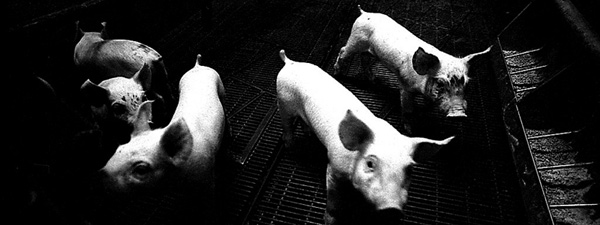Here is one of a series of photos done by Andrea L. Casiraghi, Christian Lunghi, Gianni Romano, Cristina Scalabrini, and Domenico Scorsetti.
Here is the link to the rest of the series. They are very dark photos of pigs being raised for slaughter.
Tag Archives: Hannah Warren
More Beautiful Animal Photography
Link
Week 6 Response
Aside
I like the idea of using light as a way of manipulation of that way someone looks, such as the strategies that cinematographers used with people in movies. I find it interesting that using light on a subject can greatly change the character to a viewer, and change the tone in the room. Wherever the shadows fall on a face of a subject could attract or frighten a viewer.
I have very limited experience with natural and artificial lighting, but I can say one is not easier to photograph with than the other. I like using artificial light because I can control more what I am doing, but it is still difficult to find what I am looking for in a studio environment. Natural lighting is not consistent or planned, but can be perfect at the right times. Also it is a nice way to experiment and understand what the best times of day are for photos. Harsh daylight is not always ideal, but cloudy days usually are more successful.
Week 3 post
I first learned in 209 about how to develop film, but never really understood how the chemicals worked. Having an understanding of this from the book helps me take care when I develop film, and alos understand how to manipulate it. I only understood that you can take out your film after it has sat in fixer, but I didn’t know that was because it dissolved the light sensitive silver that remained. I also learned how to “push” development of film by over developing the film.
Michael Kenna talked about doing this in one of his interviews, but by pulling back on developing in darker photos, or photos taken at nighttime.
The passage also compares the difference of all RC a fiber paper brands which I find very helpful since the tone of a print could change it dramatically.
Week 5 reading
I think this reading reminded of a time a long time ago when I though of photography as a very different art form. I thought of it more as a art of documentation and capture, and when I look at photography now and in the this book, that idea has broadened hugely. I suppose many of the work shown in this reading made me think of installation or performance art, but it really is more of a part of it.
Ballad of Sexual Dependency was one example. But the work itself that told a story had to be shared and what seemed the best way possible was through the slideshow. I remember my dad showing his pictures with our slideshow, and I know he has them stored away in a box as well as on a hard drive. Seeing slide film disappear nowadays makes me a little sad to se such an iconic method of sharing art go.
Scientific Art
Link
I remember hearing about this photographer in photo class, but also from a radio show called this american life. The stuff this woman does is a little graphic and gross, but very interesting.
Week 2 Reading
Although I remember reading this before, it helps to go over it again and review the basics of the pinhole and the benefits of a viewfinder. After using several different kinds of cameras I found that I could never warm up the the kinds of cameras with viewfinders separate from the lens. I love my SLR Nikon and felt more comfortable making a nice composition with that camera rather than the Holga in 290 last quarter. I admit my worst problem was very very embarrassing when we had to use disposable cameras and most of the pictures were blocked out by one of my fingers. I was not proud. Most people have no problem with the parallax error, but I really hated it.
I’m also interested in playing around with blurring techniques in photoshop for fun, but I also want to have more time with the 4 x 5 to play with that same technique.
I bought some magnification lenses a while ago which are discussed in the reading and I have only tried them out on a digital camera since they are not completely easy to use. They allow one to shoot something much closer that what a normal camera lens would allow, but can be very sensitive!
Reading Assignment 1 (8 am)
I HOPE I am doing this right since I am useless at blogging…
I know I am not the first to say that the reading was very informal and helpful especially for a rookie like me! I’m pretty satisfied with how much is covered in the book, and so much in addition besides cameras. I honestly did not know that you could turn a watermelon into a pinhole camera, or I suppose anything that is hollow could be turned into a pinhole camera…
I was planning on looking at instructional videos to make sure I was loading my film correctly but the book pretty much covers all I need to know.
It also helps to get a grasp of aperture and shudder speed in visuals, so you have an idea on what to expect. I have seen other examples when my father photographs moving waterfalls and streams. Its when the camera is set on a tripod and the shudder speed is very slow, so the motion of the water is very slow and the water has a smooth texture.

